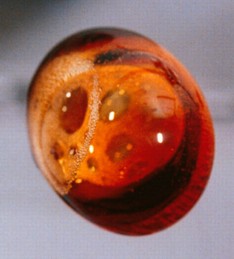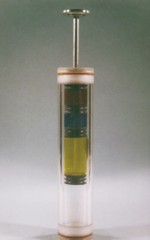|
Bubbly, frothing and ticklish - soft drinks
and beer promise a welcome taste of home to faraway space travellers.
by Patrick L. Barry
People can endure many discomforts
in exchange for the thrill of living in space. The nausea of space
sickness, fitful sleep without the familiar pressure of a bed, tasteless
meals eaten from plastic bags - it's all fine as long as the novelty
of being in space lasts.
But after a while, the blush of excitement
inevitably fades, and astronauts will begin to long for the comforts
of home. For example, the nose-tickling bubbles of a refreshing
soft drink or a frothy beer after work - these simple pleasures
that we take for granted on Earth could do wonders for morale among
long-term space travellers.
Of all the carbonated beverages people
enjoy drinking today, beer is the oldest and most familiar. Beer
has likely been a part of society since human civilization first
arose. Historians believe that the ancient Mesopotamian's and Sumerians
were brewing beer as early as 10,000 BC. The ancient Egyptians and
Chinese brewed beer, as did pre-Columbian civilizations in the Americas.
For the tradition of beer and its fizzy
cousins to continue as people begin settling space, a few questions
must first be answered.
Will fermentation work the same in weightlessness? What happens
to carbonation when there's no buoyancy to bring the bubbles to
the top? Can space beer form a proper head? Scientists who study
the physics of gas-liquid mixtures would love to know!
Two separate space shuttle experiments
tackled these questions. Both were engineered and mediated by BioServe
Space Technologies, a NASA-sponsored Commercial
Space Centre at the University of Colorado at Boulder. NASA's Space Product Development (SPD) program encourages
the commercialisation of space by industry through 17 such CSCs.

A fizzy Coca-Cola droplet
floats aboard the Space Shuttle in August 1985. In a weightless
environment, bubbles of carbon dioxide ("carbonation") aren't
buoyant, so they remain randomly distributed in the fluid.
The result can be a foamy mess!
|
Kirsten Sterrett, a University of Colorado graduate
student, first became interested in how beer would brew in space
while working at the Coors Brewing Company. Having studied aerospace
engineering as an undergraduate, she began to wonder: How would
yeast that perform fermentation fare in orbital free fall? The answer
would not only shed light on the possible making of space-beer,
but also provide valuable information to pharmaceutical companies
with a keen interest in the biology of orbiting microbes.
When she returned to CU-Boulder
for her master's work, she chose the topic for her thesis. Her
experiments were sponsored by Coors and flown on the shuttle with
the help of BioServe.
"I always said I wouldn't do an experiment that I couldn't eat or
drink in the end," she jokes.
"Actually, after the experiment was all done, I gave (the space-beer)
a little taste." The sample was only about 1 ml, which wasn't really
enough to savor, she says, "but why throw something like that away?"
Along with her taste test, Sterrett
performed a protein analysis on the beer and the yeast, measured
the beer's specific gravity (the force exerted on it by gravity
per unit volume), and "repitched" the yeast by brewing subsequent
batches of beer with it. By all of these measures, the space-beer
appeared to be essentially the same as beer brewed on Earth.
The behaviour of the yeast was somewhat
puzzling, though. The total cell count in space-borne samples was
lower that of "control" samples brewed on the ground, and the percentage
of live cells was also lower. One of the yeast's proteins also existed
in greater amounts in the space-brew.

Probably the oldest carbonated beverage still
consumed today, beer has a long and rich tradition.
|
Sterrett's experiment couldn't suggest reasons for these changes,
but the overly abundant protein bears some resemblance to a general
stress protein.
The low cell count was particularly surprising, says Sterrett. In
space, yeast cells remain evenly dispersed within the "wort" -
a brewers' term for the pre-fermentation mixture of water, barley,
hops, and yeast. Ideally, this would give the yeast cells better
access to nutrients in the wort compared to similar mixtures on
Earth, where the weight of the cells causes them to pile at the
bottom one on top of the other.
"It's the same question that we're asking on the pharmaceutical
side," says Louis Stodieck, director of BioServe.
"We know from subsequent space experiments sponsored by Bristol-Myers
Squibb Pharmaceutical Research Institute that the efficiency of
producing fermentation products increases [in a weightless environment],
in fact quite significantly." Some of those experiments produced
as much as three times the fermentation products as control samples
on the ground.
 A far
cry from the copper vats used to brew beer here on Earth,
this
Fluid Processing Apparatus was used by Sterrett to ferment a tiny batch of space-brew.
|
Pharmaceutical companies frequently
use genetically-engineered microbes - usually bacteria - to produce
medicinally-valuable proteins such as
antibiotics
through fermentation. By introducing the gene that codes
for the protein into the bacteria's DNA, scientists convert the
microbes into inexpensive, self-replicating medicine micro-factories.
Space research with microbe fermentation
might help improve this process.
"What
we're trying to do now is to find the specific mechanism of that
(increased fermentation efficiency in space), and then we can ask
whether we can modify the fermentation process on Earth to take
advantage of that - or is it possible that we could genetically
engineer an organism to mimic what it does in space," Stodieck says.
A more efficient fermentation
process, even by a small percentage, could potentially save millions
of dollars in production costs.
For beer, of course, increased fermentation
efficiency means a more alcoholic brew - not necessarily good news
for crew members who need to remain sober in the dangerous environment
of space. The alcohol content of space-brews would need to be adjusted
accordingly and, of course, consumed in moderation.
But for alcohol content to even matter, future space residents will
first have to get the beer into a drinking container - a trickier
feat than it may seem.
"How do you dispense a beverage and keep the carbonation in solution
until the person is ready to drink?" Stodieck
asks. "That's the challenge."
Changes in temperature and pressure,
or even physical agitation of the beverage as it's dispensed, can
cause carbonation to come out of solution prematurely. Because bubbles
don't rise in free-fall the result can be a foamy mass.
This problem was addressed by experiments
flown on the shuttle by The Coca-Cola Company, again with the help
of BioServe. "They (The Coca-Cola Company) have a lot of technology
that they develop for future ways of providing their drinks anywhere
and everywhere," Stodieck notes. And indeed,
their dispensing device flown on the shuttle managed to serve a drinkable
cola. It controlled the temperature of the beverage during mixing
and dispensing with computer accuracy, and minimized agitation.

Image Courtesy Bioserve
By dispensing the drink into a collapsible bag inside the
bottle, the pressure around the fluid can be constantly
controlled, thus preventing the carbonation from coming
out of solution too quickly. The image on the right shows
the dispenser being used aboard the space shuttle. (Note
there is a tape stuck to the top-right corner of the dispenser
that reads "50¢" - astronaut humour).
|
Similar technology should prove effective
for carbonated space beers. Unfortunately it doesn't lend itself
to the traditional frosty glass mug! Instead, beverages are dispensed
into a special bottle (pictured above) that screws onto the dispenser.
The bottle itself, which contains a collapsible bag, is internally
pressurized. The pressure around the bag is slowly released as the
beverage enters, maintaining the drink under constant pressure and
producing a palatable soda or beer.
So maybe it's not exactly like having a beer on Earth, but
astronauts might nevertheless welcome a sip from the strange contraption.
Bubbly, frothing, and ticklish - it's a welcome taste of home.
|
